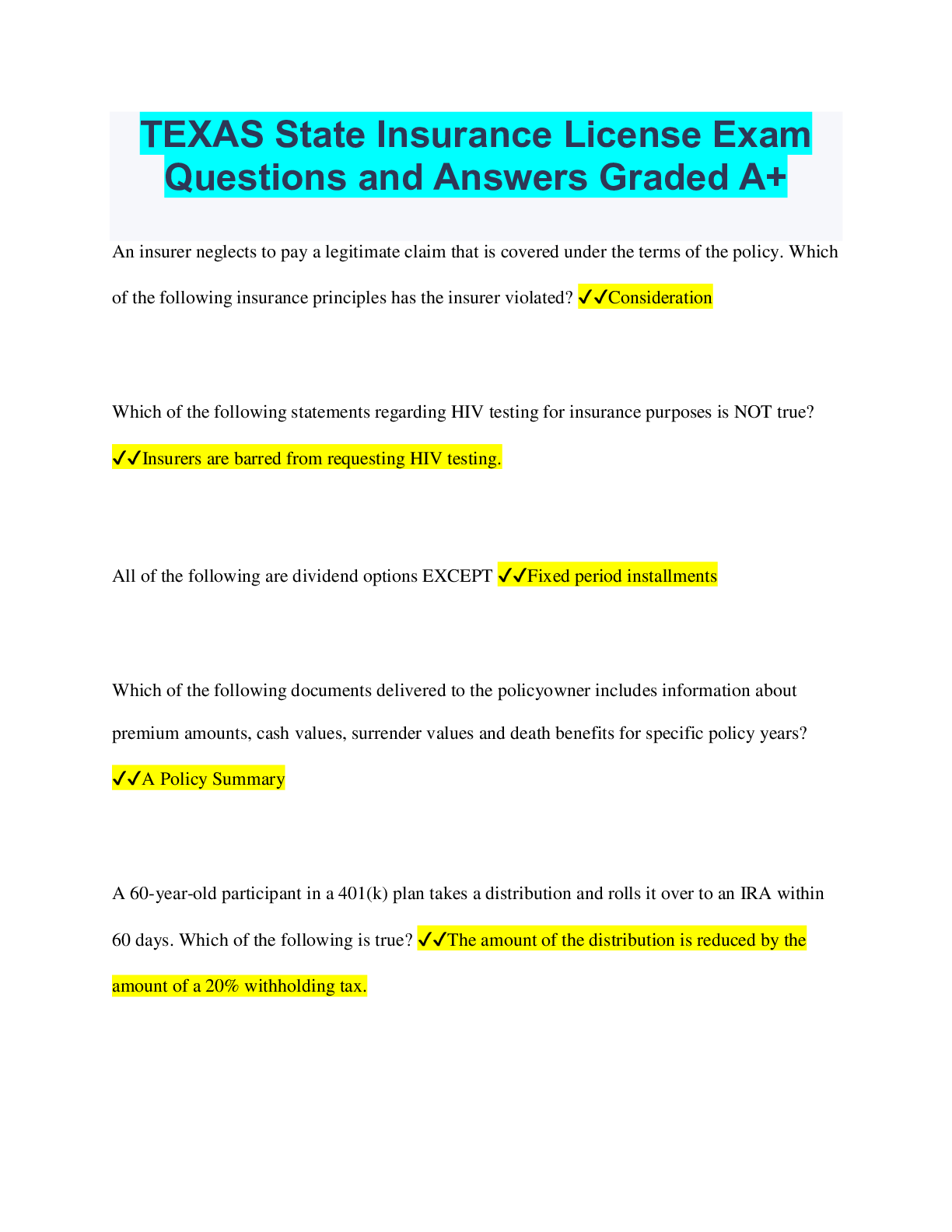Counseling > QUESTIONS & ANSWERS > NCMHCE Top Exam Questions and answers, 100% Accurate, rated A+ (All)
NCMHCE Top Exam Questions and answers, 100% Accurate, rated A+
Document Content and Description Below
NCMHCE Top Exam Questions and answers, 100% Accurate, rated A+ STEPS IN REALITY THERAPY - ✔✔-In addition to societal standards, every person is assumed to have a set of personal standards. Whe... n a client is operating contrary to personal or societal standards, more effective behaviors must be chosen. Therapy is an exercise aimed at greater fulfillment of the individual's needs. Since the focus is upon helping the client to make more effective behavior choices in the present, reality therapy considers antecedent experiences and outside forces to be of little import. Eight basic steps of reality therapy: 1. Having established a friendly relationship, the counselor finds out from the client what he/or she wants. 2. Counselor and client determine what the client is doing to achieve the desired end. 3. The counselor helps the client evaluate how effective his/or her behavior is in achieving the goal. 4. The counselor helps the client make a plan to gain effective control over the situation/environment. 5. The counselor exacts a commitment to follow through on the plan. 6. Excuses for failure are not accepted. 7. If possible, the counselor imposes reasonable consequences if the plan is not carried out, such as temporary restrictions of freedom or temporary removal of privileges. 8. The client is not allowed to control the counselor by simply giving up. If one plan does not work, the counselor and client amend it or create another, until the client implements a plan and begins to take control of his/or her life. Though Glasser conceded that such individual control can take a long time to achieve, he argued that it would succeed because it is the individual who controls the environment, rather than the environment controlling the individual. JUNGIAN THERAPY - ✔✔-The focus of this therapy is to help clients live authentically, as who they are intended to be, bringing internal struggles (opposites) into harmony, and to fully individuate in the archetype of wholeness. Techniques: 1. Analysis of transference - four stages are addressed: a. The client's personal history projections onto the therapist b. The client differentiates his/or her own unconscious from the collective c. The therapist's reality is differentiated from the superimposed images d. The achievement of greater knowledge and insight within the self having worked through the transference and into an authentic relationship with the therapist 2. Active imagination - one identifies an entity (i.e. shadow figure, anima, maternal figure, male) through a dream or other scene, and he/or she activates attention to the figure through meditation. The client is invited to enter the scene and dialogue with the entity, usually one that has qualities opposite the ego, thereby accessing rejected elements and availing them to the conscious mind. This may be done in writing, art, sculpting, dance, or other medium. 3. Dream analysis - Jung believed that images are a reflection of something within the person, and that the dream world could allow the individual access to the unconscious within the self, specific to the dreamer. 4. Individuation - involves the development of the individual's personality via making conscious the individual's unconscious and the collective unconscious tendencies. It is considered to be both a goal and something to develop throughout the lifespan. 5. Sandplay - involves the use of a tray of sand for free expression, often used with figures, symbols, avatars, or other miniature objects. This engages both children and adults in free expression and has been used successfully in a variety of trauma work. 6. Shadow work - addresses the qualities that do not fit our image of ourselves - anger, hatred, jealousy, greed, lust, and shame. It also address behaviors that are not culturally acceptable such as aggression, addiction, and dependency. The goal is to integrate parts of ourselves that we try to hide from. 7. Journaling - allows the client to keep track of thoughts, feelings and behaviors so they can see their progress during therapy. 8. Rituals - involves a series of actions involving the entire family in a sequence of steps, forming a play that is to be enacted under specific circumstances. An example of a ritual is a family sitting together daily, each getting equal time to speak well of the family, with no negative opinions allowed. FREUD - PERSONALITY STRUCTURE AND MOTIVATIONAL INSTINCTS - ✔✔-The Id, Ego, and Superego: 1. Id - primitive, selfish aspect demanding immediate gratification by increasing pleasure and reducing tension. 2. Ego - grounded in reality, the ego is responsible for mediating between the id and the superego; it functions in the conscious, preconscious, and unconscious mind. 3. Superego - internalization of parental interjections (extreme); made up of the "ego ideal" and the "conscience". Motivational Instincts: 1. Libido - sexual and ego drives found in the id 2. Aggression - death instincts 3. Neurosis - results when the superego imposes guilt on the ego to limit the impulses of the id. Neuroses stem from childhood conflicts that occur when the balance between the libido and ego mechanisms are unbalanced. KEY FREUDIAN TERMS - ✔✔-1. Manifest Latent Dreams: Dreams are composites of symbols derived from recent and remote memories and formed by the current feelings, attitudes, and motivations of the individual. Shaped by the immediate psychological needs of the sleeper, manifest latent dreams are distortions of life experiences in accordance with the regressive thinking processes that prevail during sleep. 2. Manifest Content: Formed as a composite of recent and distant memories, this is the apparent content of the dream. Actually, it provides a mask for events that conceal the latent meaning of a dream. 3. Latent Content: Underlying thoughts, desires, and fantasies related to the emotional reactions of early infancy; latent content gives a dream its fundamental meaning. 4. Dream Work: This is a process whereby latent dream content becomes apparent. An individual gains understanding of the fundamental meaning of a dream by exploring early experiences, attitudes toward parents and siblings, and defenses and conditionings, as well as emotionally charged current life experiences, interpersonal dynamics, and repressed unconscious impulses. REALITY THERAPY - WILLIAM GLASSER - ✔✔-Rejecting the concept of mental illness, reality therapists do not bill using the DSM-5 because they do not believe in the pathology model. As might be inferred from the name reality therapy, this approach encourages the client to face reality without excuses or explanations. In reality therapy, individuals are seen as possessing two psychological needs: 1. The need to love and to be loved 2. The need to feel worthwhile to themselves and to others Developed by William Glasser, reality therapy proceeds on the theory that the brain functions as a system to control behavior by fulfilling needs created by the environment. When an individual is unable to control or effectively act on such environmentally based needs, problems result. Reality therapy seeks to help clients choose actions that satisfy basic needs of survival, reproduction, power, freedom, and fun. With this model, behavior is an integration of a person's feelings, thoughts, and actions. Relating personal needs to behaviors of others, action comes from within and is dependent upon the needs it means to satisfy. REALITY THERAPY - HERE-AND-NOW - ✔✔-Here-and-Now: 1. The content involves immediate events in the session, not past occurrences or even current outside events. 2. The process is cognitive, a self-reflective loop determined by the nature of the relationship between interacting individuals. 3. The content process includes abstract, specific, generic, and personal information as guided by the needs of the group at any given time. Here-and-Now Tasks of the Therapist: 1. First stage: activating phases aim to move group into the here-and-now. As an example, it is the leader who sets the norms for interpersonal confrontation, emotional expression, and self-monitoring, and who demonstrates the value placed upon the group as a source of good information. 2. Second stage: process illumination is employed. 3. The counselor acts as observer-participant and group historian. In this role, the therapist should comment on the process, eventually helping members to process as well. 4. Uncovering should not be used to understand the past, but toward understanding the present. 5. Here-and-now (content) and process should overlap. DEFENSE MECHANISMS - ✔✔-1. Compensation - defenses against feelings of inferiority and inadequacy growing out of real or imagined personal defects or weaknesses. 2. Conversion - somatic changes expressed in symbolic body language. Psychic pain is given a location in some body part. 3. Denial - avoidance of awareness of some painful aspect of reality. 4. Displacement - investment of repressed feelings in a substitute object. 5. Association (Anna Freud's altruism) - obtaining gratification through association with and helping another person who is gratifying the same instincts. 6. Identification - the process whereby an individual becomes like another person in one or several respects. This is a more elaborate process than introjection. 7. Introjection - taking in of an idea or image so that it becomes part of oneself. Introjection is an assimilation of object representations into the self representation whenever the boundaries between the self and the object are blurred. 8. Inversion (turning against yourself) - object of the aggressive drive or impulse is changed from another person to you. This is operative especially in depression and masochism. 9. Isolation of affect - a splitting off of ideas from the feelings originally associated with them. The idea which remains in the consciousness is therefore deprived of its motivational force so that action is thwarted and guilt avoided. 10. Intellectualization - the psychological binding of instinctual drives in intellectual activities. Adolescent preoccupation with philosophy and religion is one common example. 11. Projection - attributing a painful impulse or idea to the external world. 12. Rationalization - an attempt to give a logical explanation for painful unconscious material to avoid such feelings as guilt and shame. 13. Reaction formation - replacement in the conscious awareness of a painful idea or feeling by its opposite. The unconscious material remains along with the conscious presence of its opposite. 14. Regression - a retreat to an earlier phase of psychosexual development. 15. Repression - the act of obliterating material from the conscious awareness. Repression is a special, unique defense, capable of mastering powerful impulses. 16. Reversal - a form of reaction formation aimed at protecting oneself from painful affects. 17. Splitting - external objects are either "all good" or "all bad". Sudden shifts of feelings and conceptualizations about an object may occur from one category to the other. 18. Sublimation - the deflection of the energies of instinctual drives to aims that are more acceptable to the ego and superego. 19. Substitution - the substitution of one affect for another. For example, rage used to mask fear. 20. Undoing - a ritualistic performance of the opposite of an act a person has recently committed in order to cancel out or balance the evil that may have lurked in the act. 21. Identification with the aggressor - a child introjects some characteristic of an anxiety-evoking object and consequently assimilates an anxiety experience which he has just undergone. Thus, the child is able to transform himself from the person threatened to the person who makes the threat. REALITY THERAPY - ROLE OF THE THERAPIST - ✔✔-In helping patients assume a process orientation, the therapist must: 1. Be a mature leader who resists the temptation to make brilliant interventions 2. Help the clients accept process-illuminating comments such as "I am not sure what's happening with Bill." 3. Realize clients are always more receptive to observations delivered supportively. 4. Not make global accusations. Instead of saying someone is dependent, make a statement that indicates an observation of times of closeness and other times of aloofness. Process comments: 1. "Your behavior is like..." 2. "Your behavior makes others feel..." 3. "Your beliefs influence the opinions others have of you by..." 4. "Your actions affect self-esteem by..." SCHIZOPHRENIA - SYMPTOM CHARACTERISTICS AND DIAGNOSIS - ✔✔-Individuals with Schizophrenia display odd, unusual, and idiosyncratic behavior that results from defects in ego functioning. One aspect of this is the loosening of ego boundaries. What I mean by fluid or loose ego boundaries is that there seems to be difficulty distinguishing internal fantasy and thoughts from external reality. Moreover, one's internal world is not integrated. There appears to be internal chaos, confusion, and sometimes, overwhelming anxiety. This is the result of impairment in the primary autonomous ego functions. This constitutes basic contact with reality and integration of thoughts, feelings, and perceptions. In the acute phase of Schizophrenia, there are five areas of disturbance (symptoms) that should be assessed. These include a disturbance of: 1. Thought form 2. Thought content 3. Perception 4. Emotion 5. Behavior Most of these symptoms will be readily apparent in an interview. Terms: 1. Disturbance of Thought Form: Thinking is illogical and often incomprehensible. 2. Loose Associations: Disconnection of ideas - jumping from topic to topic, often mid-sentence. 3. Overinclusivness: Use of irrelevant information that interrupts logical thought. 4. Neologisms: Creation of new words - may have meaning to the client. 5. Blocking: Speech simply stops mid-sentence; speech may start again in a few minutes, often in another place. This may be the interference of hallucinations. 6. Clanging: Choice of words based on sounds - the client often rhymes a primary word in one sentence with a word in a previous sentence. 7. Echolalia: Repeating words without concern for meaning. 8. Concreteness: Lack of ability to think in abstract terms. 9. Alogia: Also called poverty of speech. Speaks little, without intentional resistance. Individuals with Schizophrenia appear to be caught up in an idiosyncratic world and have a relatively "unique" way of communicating. Other psychotic disorders may exhibit disturbance of thought. Schizophreniform Disorder is virtually identical in the initial clinical presentation to Schizophrenia except: 1. There is a shorter duration. 2. The diagnosis does not require impaired occupational or social functioning (however, it is hard to imagine how psychosis would not impair functioning). SCHIZOPHRENIA - DELUSIONS AND HALLUCINATIONS - ✔✔-While Schizophrenia is considered a chronic illness, the course of the illness appears to follow several stages (often classified according to the particular point of view or theoretical orientation of the clinician). Of course, the DSM-5 is considered non-theoretical as to diagnosis and etiology. The DSM-5 is empirically based and is organized into diagnostic categories according to symptoms. The DSM-5 has removed the old DSM-IV subtypes (paranoid, disorganized, catatonic, undifferentiated, and residual). Now, specifiers include: first episode or multiple episodes, currently in acute episode, currently in partial remission, or currently in full remission; continuous; and unspecified. With this said, let's look further at the acute symptoms as they may manifest in the clinical situation. Delusions are fixed false beliefs that are usually incredible and beyond belief. The DSM-5 no longer includes the attribution of "bizarre delusions". The thinking here is that it's actually quite difficult to distinguish between "bizarre" and "non-bizarre". The following are some of the types of delusions that might be seen: 1. Confused delusions with no systematic content 2. Persecutory delusions that are also relatively without systematic form 3. Delusions of grandeur (e.g. "I am the second coming of Christ." or "I am the President."). 4. Delusions of influence (e.g. "I have powers of mind control and can make you stand on your head if I want."). 5. Ideas of reference (e.g. Casual events of others are seen as being directed toward the individual). 6. Thought insertion (e.g. "The FBI is transmitting thoug [Show More]
Last updated: 1 year ago
Preview 1 out of 24 pages

Also available in bundle (1)

NCMHCE Assessments BUNDLE, VERIFIED EXAM PAPERS
NCMHCE Assessments Top Exam Questions and answers. 100% Accurate. verified. 17 VERSIONS 2023/2024
By Topmark 1 year ago
$45
16
Reviews( 0 )
Document information
Connected school, study & course
About the document
Uploaded On
Mar 12, 2023
Number of pages
24
Written in
Additional information
This document has been written for:
Uploaded
Mar 12, 2023
Downloads
0
Views
69






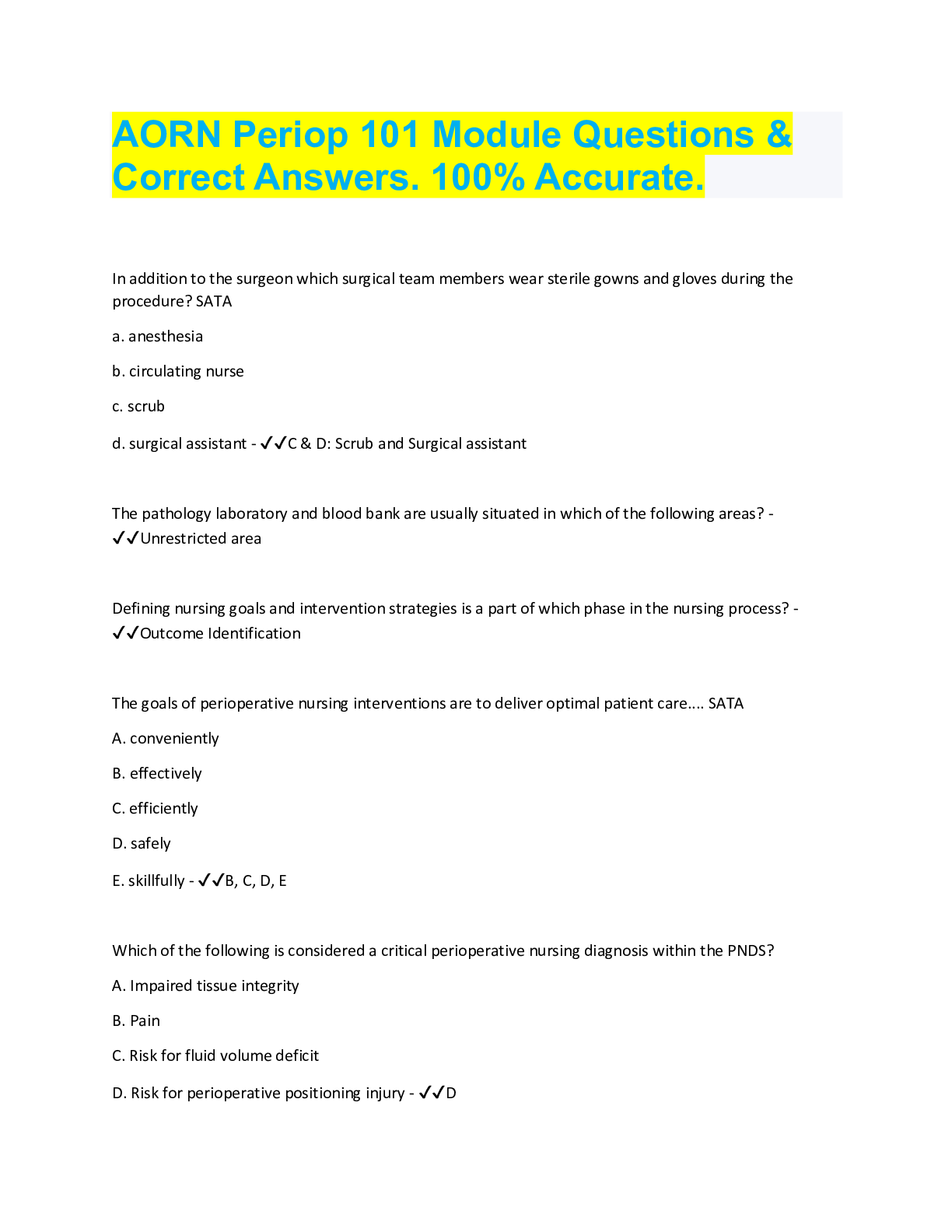





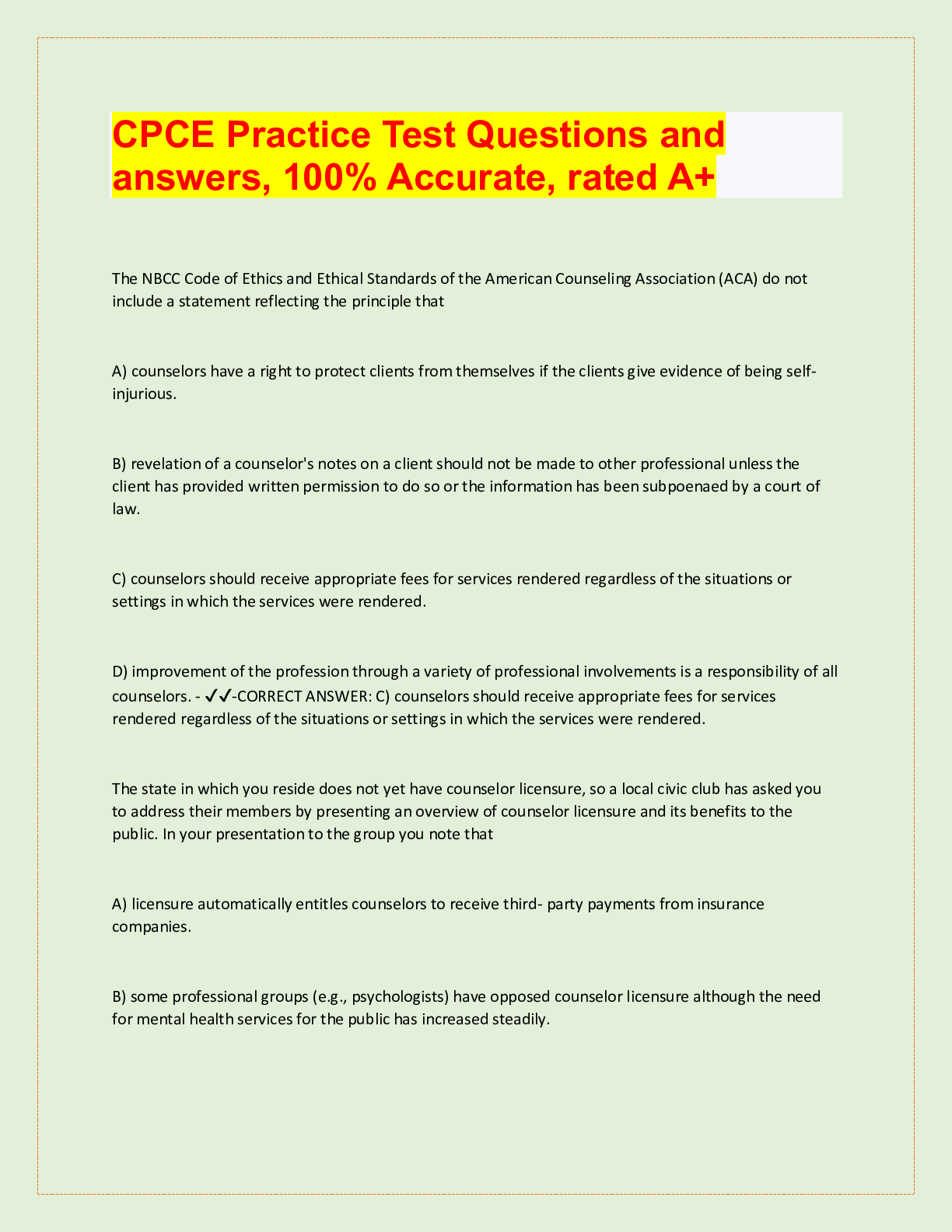


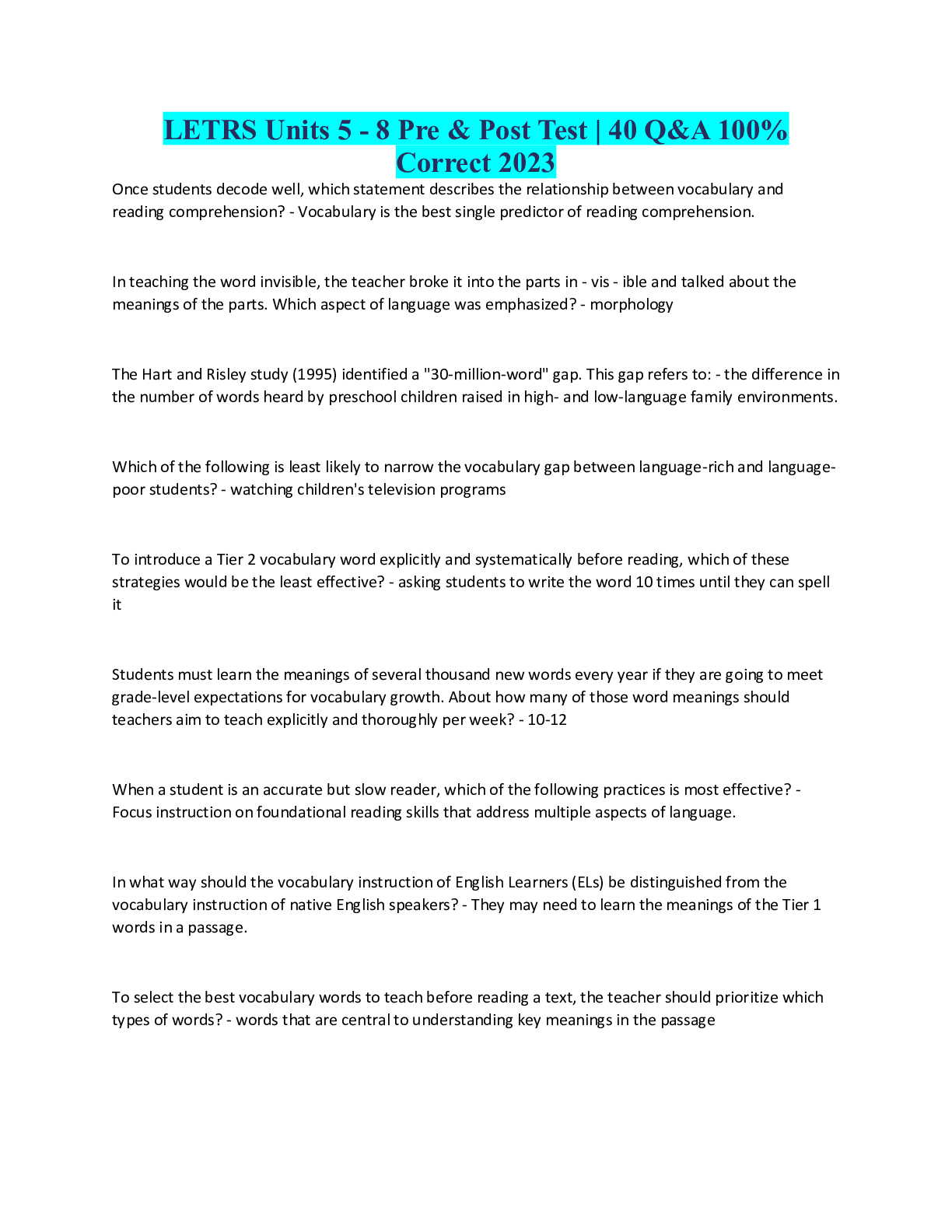
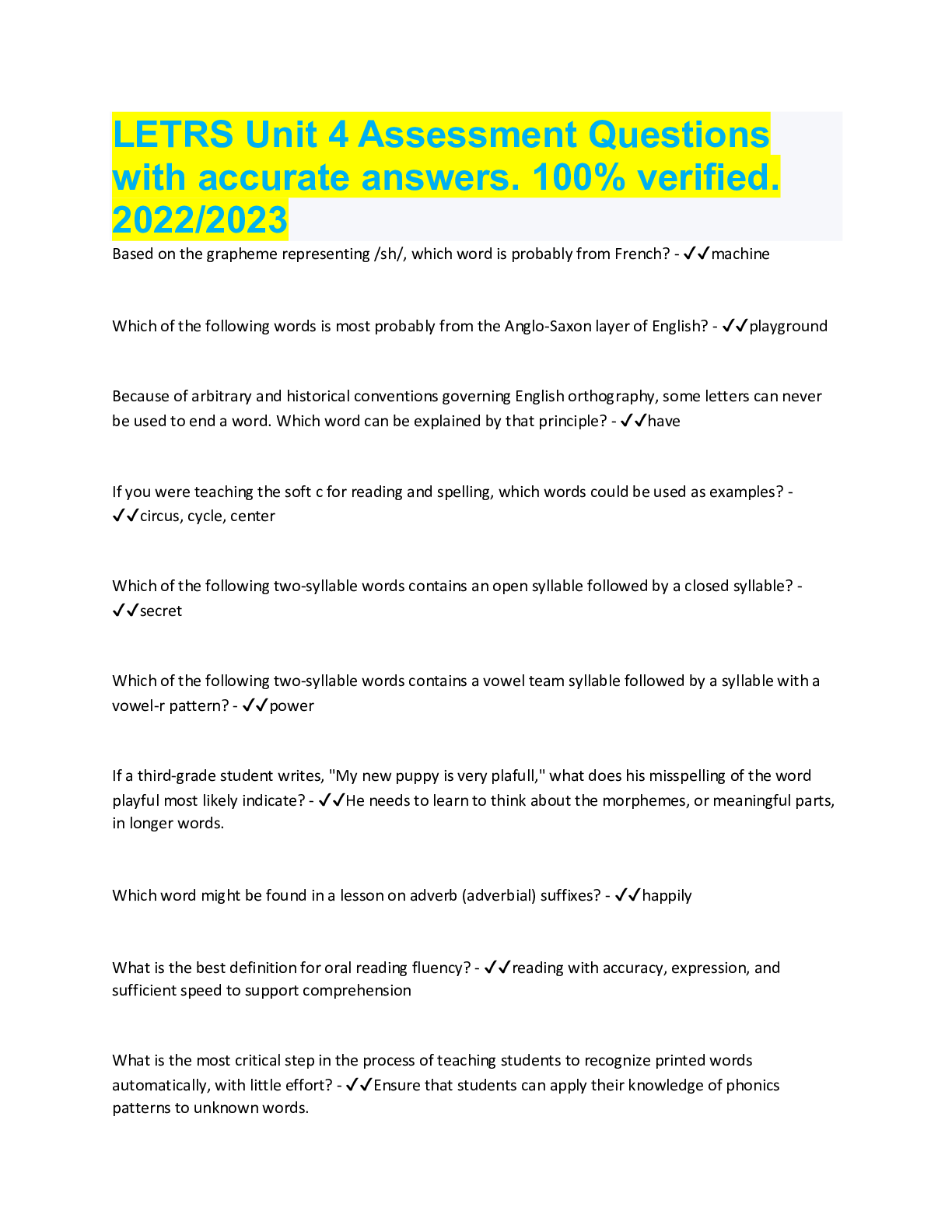
.png)


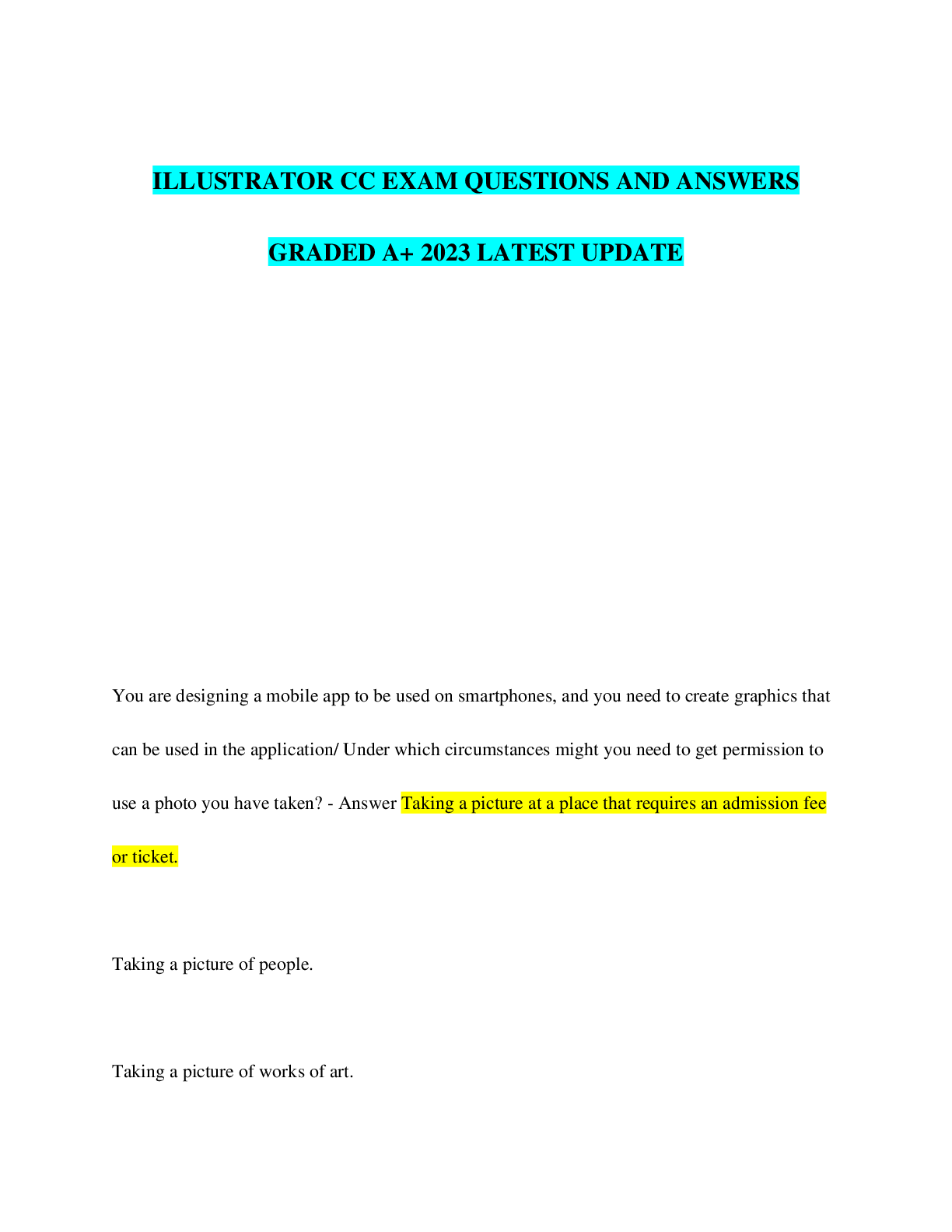
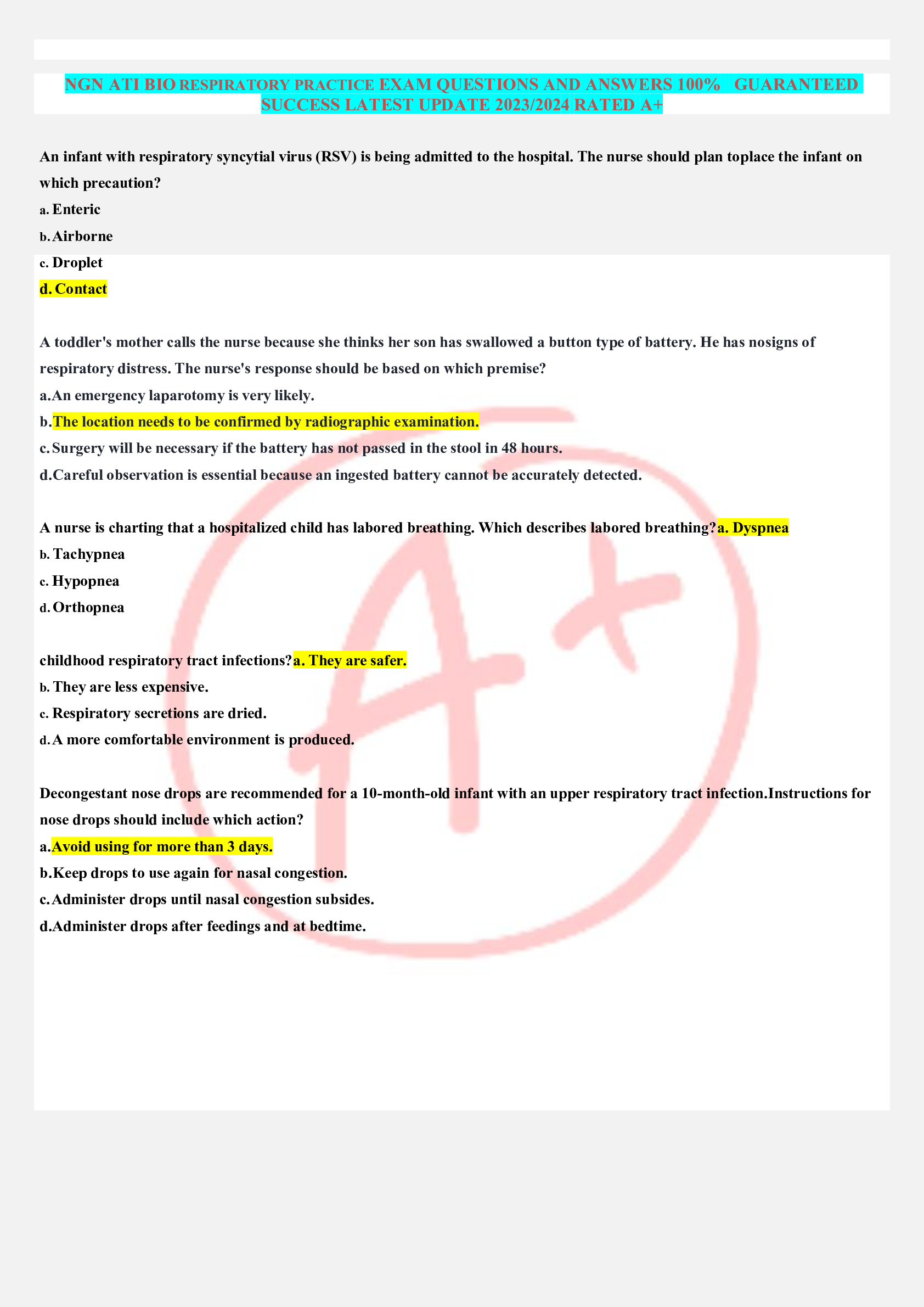

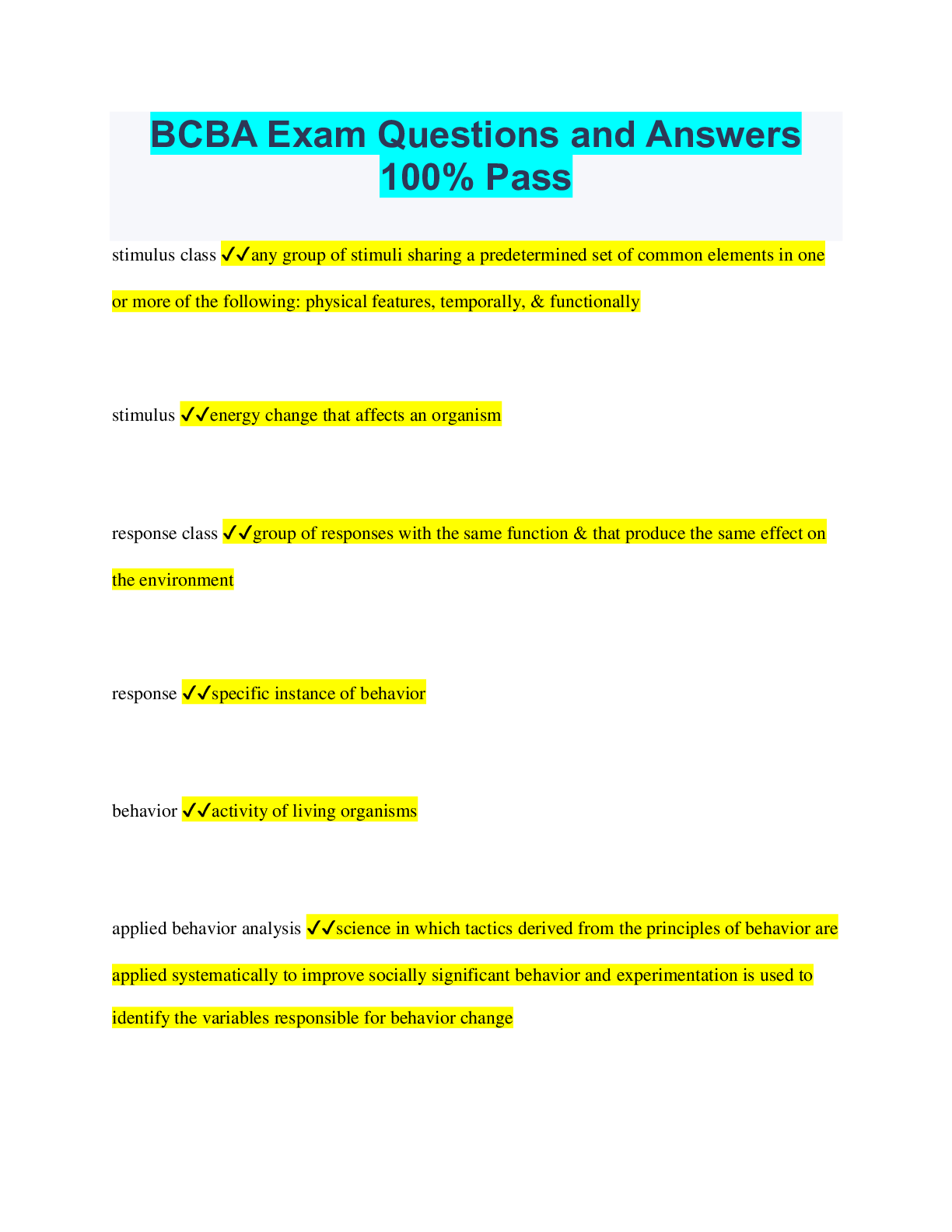
.png)
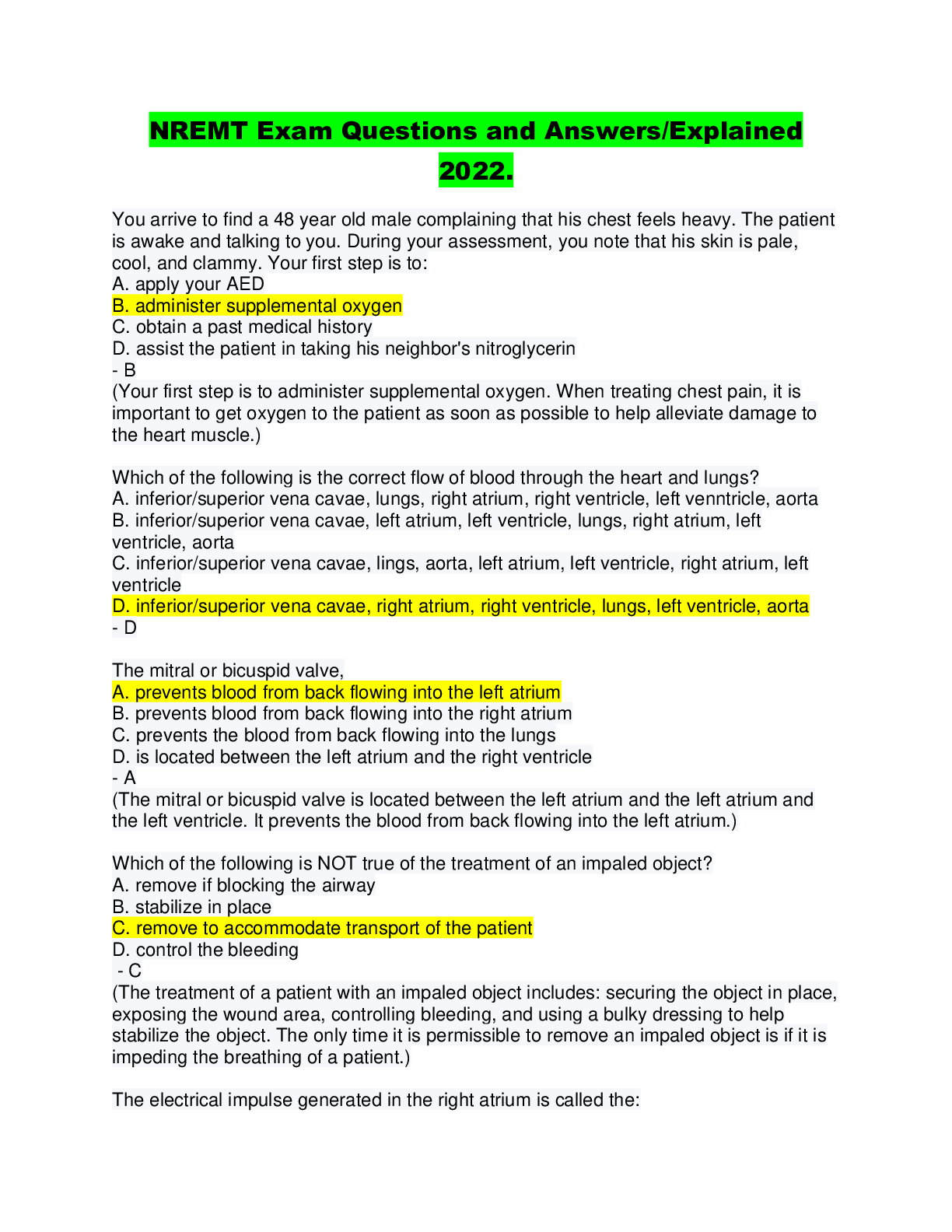
.png)
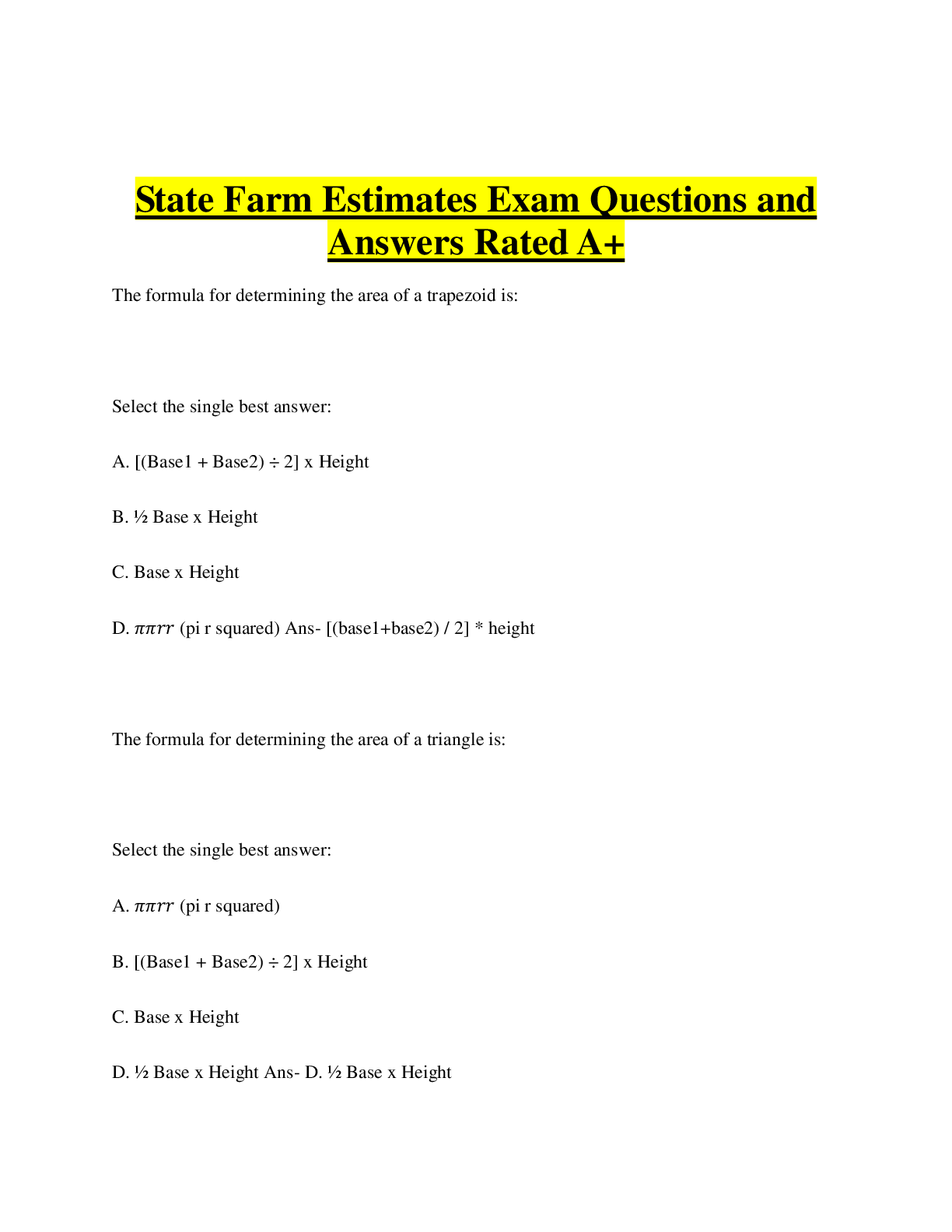

.png)


